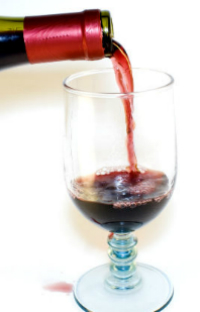Wine chlorophenols: Countercurrent chromatography with ionic liquids
Wine taint

The cork taint that appears in some wines is a result of contamination from the cork, specifically the transfer of compounds known as chlorophenols. The main culprit is thought to be 2,4,6-trichloroanisole which derives from the chlorine bleach that is used in cork processing and is applied routinely in wineries as a disinfectant.
Other types of chlorophenols are used as pesticides, bactericides, herbicides, fungicides and wood preservatives and they provide another route into vines and their grapes. These include various mono-, di- and trichlorophenols, some of which have been classified as Priority Pollutants by the US EPA due to their persistence in the environment and their toxicity.
Even trace amounts of chlorophenols are sufficient to spoil wines, so sensitive analytical methods are needed, first to remove them from the wine then to identify and measure them. One group of scientists working in China has adapted the established technique of countercurrent chromatography (CCC) for extracting these contaminants from red wine by adding an ionic liquid as a modifier to the solvents. Xueli Cao, Chen Fan and Nai Li from Beijing Technology and Business University described their novel approach in Journal of Separation Science.
Countercurrent liquid phases
In CCC, a liquid mobile phase representing the sample is forced through a liquid stationary phase during which the target analytes are transferred from one to the other. The absence of a solid support eliminates any irreversible surface adsorption effects and the continuous nature of the process can lead to high partition/extraction efficiencies. A third mobile phase is then passed through the stationary phase to elute the analytes for analysis.
In this case, the stationary phase was dichloromethane modified with the ionic liquid 1-butyl-3-methylimidazolium bis(trifluoromethylsulphonyl)imide. In its absence, partition of chlorophenols from the aqueous sample was low and unstable, leading to poor recoveries. However, when just 2% of the ionic liquid was added, the recoveries were vastly improved.
The whole process is quite simple. A multilayer-coiled CCC column was filled completely with the dichloromethane stationary phase containing ionic liquid. It was rotated at 1400 rpm while ultrapure water was added as the mobile phase until dynamic equilibrium was reached, exemplified by water emerging from the end of the column.
The sample was added next, using a standard aqueous solution of 2- and 3-chlorophenol, 2,4- and 2,6-dichlorophenol and 2,4,5- and 2,4,6-trichlorophenol for optimisation. For 50 mL of sample flowing at 3 ml/min, loading was complete in 20 minutes and the chlorophenols were partitioned to the stationary phase.
Thereafter, a final solution consisting of aqueous sodium carbonate was passed through the column to extract the chlorophenols. As this solution emerged from the column, it passed by a UV detector to locate the chlorophenol fractions which were analysed by HPLC-DAD.
Chlorophenols in red wine
The optimised procedure for the chlorophenols produced recoveries of 85-95%, which were comparable to those achieved with liquid-phase microextraction and hollow fibre-supported ionic liquid membrane extraction. The enrichment factors from water were in the range 34-65 and the detection limits were 1.89-4.21 µg/L.
Two red wines purchased from local markets were tested using the new CCC procedure. Their HPLC chromatograms were compared with those of the same wines that had been spiked with the six chlorophenols so that any peaks present could be identified as chlorophenols by matching the retention times. This revealed that one of the wines contained 4-chlorophenol, measured at 4 µg/L.
The CCC method could be extended to look for chlorophenols in other types of liquid foods or environmental samples. With careful choice of the stationary phase and ionic liquid, it could also be applied to the extraction of other contaminants.
In the long term, the organic portion of the solvent could be eliminated altogether. "With the development of high-pressure countercurrent chromatography, which is the perfect partner for ionic liquid technologies, methylene dichloride [dichloromethane] may be replaced by pure ionic liquids and its performance may be further improved through miniaturization and high throughput of CCC instruments," the researchers concluded.
